Unlock Lawn Health: The Secret Behind Solid & Hollow Aeration Tools
- March 14, 2024
- 0 comment
A lush, vibrant lawn is the cornerstone of a beautiful home exterior. However, achieving and maintaining such a lawn requires more than just regular watering and mowing. One of the most overlooked yet critical aspects of lawn care is aeration. Aeration involves perforating the soil with small holes to allow air, water, and nutrients to penetrate the grass roots. This process helps the roots grow deeply and produce a stronger, more vigorous lawn. But when it comes to aeration, the tools you choose solid or hollow can make all the difference.
The Importance of Lawn Aeration
The importance of lawn aeration cannot be overstated in the pursuit of a healthy, lush lawn. As lawns age or undergo heavy use from activities such as foot traffic and regular mowing, the soil beneath can become increasingly compacted. This compaction significantly reduces the soil’s porosity, effectively minimizing the space available for air and water to circulate. Such conditions are detrimental to the roots’ ability to absorb essential nutrients and water, vital components for the growth and health of the grass. Furthermore, compaction leads to an inhospitable environment for beneficial microorganisms that contribute to a soil’s fertility, further hampering the lawn’s vitality.
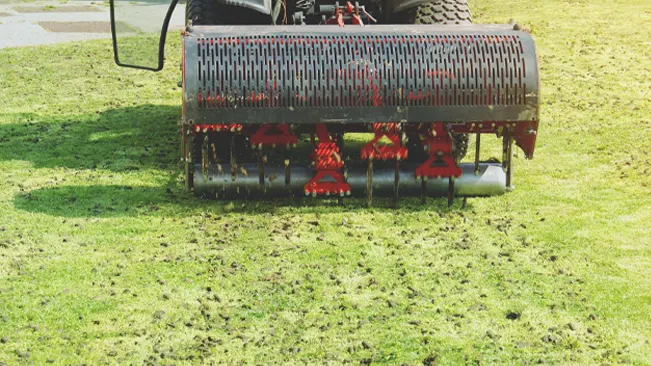
Compounding the problem of soil compaction is the formation of thatch a dense layer of both living and decomposing grass shoots, stems, and roots that accumulates on the soil’s surface, just below the green grass blades. While a thin layer of thatch can be beneficial, acting as a mulch to regulate soil temperature and moisture, an excessive buildup becomes a barrier to water, nutrients, and air, preventing these essential elements from penetrating the soil and reaching the grass roots. Through the process of aeration, small holes are created in the soil and thatch layer, breaking through these barriers. This not only improves the flow of air, water, and nutrients to the roots but also encourages deeper root growth, leading to a more resilient and vibrant lawn
Methods of Lawn Aeration
Solid Tine Aeration
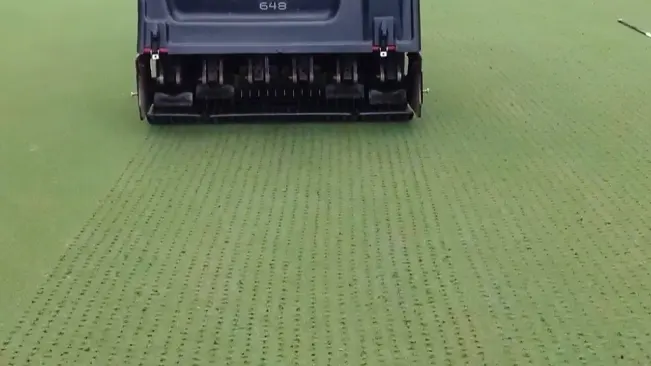
This aeration method employs solid spikes or tines to puncture the soil, creating small holes that penetrate the surface. It’s particularly beneficial for lawns with sandy soil, as the process introduces air gaps that improve the soil’s ability to transmit air and water down to the root zone. The simplicity of solid tine aeration makes it a popular choice for routine lawn maintenance, especially in areas where the soil is naturally loose and well-drained. However, caution is advised when considering this method for lawns with clay soil, as the action of the tines can lead to soil compaction around the holes. This unintended effect might inhibit root growth and water infiltration, potentially worsening soil conditions.
Hollow Tine Aeration
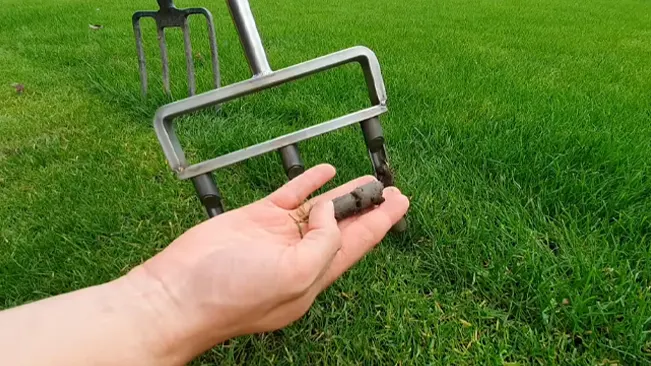
This technique is more invasive than solid tine aeration and is designed to alleviate more severe compaction issues, particularly in clay-based soils. Hollow tine aeration involves the use of coring devices that extract small plugs of soil from the lawn, leaving behind open cavities. These cavities allow the surrounding soil to loosen and expand, significantly improving aeration and drainage. The removed soil cores also provide an excellent opportunity to amend the soil with compost or sand, further enhancing soil structure and fertility. Hollow tine aeration is especially effective in preparing lawns for the stresses of hot, dry periods, as the increased air and water movement encourages deeper root growth, making the grass more resilient.
Slitting or Slicing Aeration
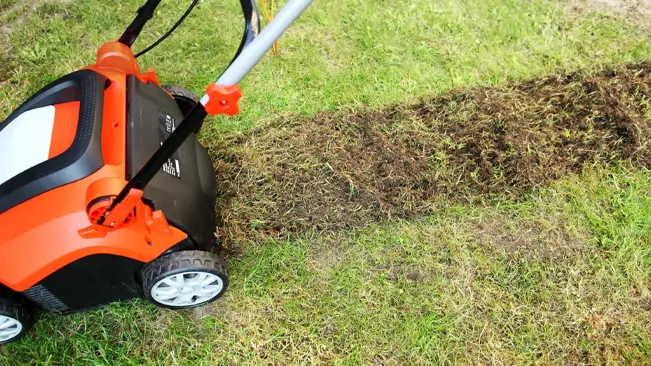
This method is distinct from the previous two in that it involves cutting into the soil and thatch layer with thin, sharp blades, rather than removing or displacing soil. The blades create narrow, vertical slits in the ground, which can be particularly beneficial for lawns with a dense thatch layer. Thatch, a buildup of dead and living organic matter at the base of the grass blades, can impede water and nutrient penetration if left unchecked. Slitting aeration breaks through this layer, improving the lawn’s overall health by enhancing soil breathability and nutrient uptake. Additionally, this method is favored when overseeding, as the slits provide an ideal environment for seed germination by improving seed-to-soil contact and moisture retention.
Solid Aeration Tools
Aeration Shoes
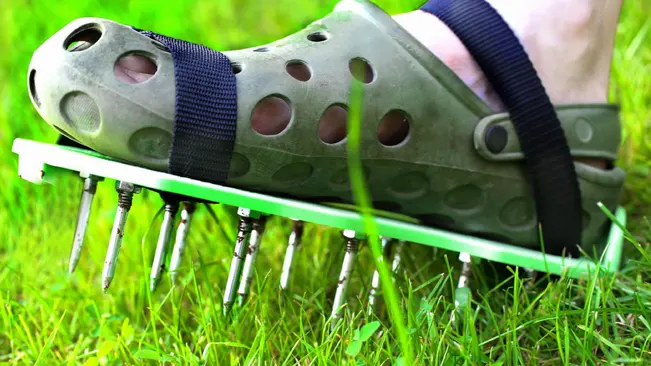
Aeration shoes are an innovative and straightforward tool for improving lawn health, especially suitable for small lawns or areas that larger aeration equipment cannot easily reach. These shoes are equipped with sturdy spikes on the bottom, transforming a simple walk across the yard into an effective aeration process. By wearing these spiked sandals, homeowners can aerate their lawn as part of their regular garden maintenance routine, without the need for heavy machinery. This method not only facilitates air and water movement in the soil but also serves as an eco-friendly and physically active way to care for the lawn. Aeration shoes are particularly useful for gardeners looking for a quick, no-fuss aeration method that can be easily stored and used at any time.
Hand-Held Aerators
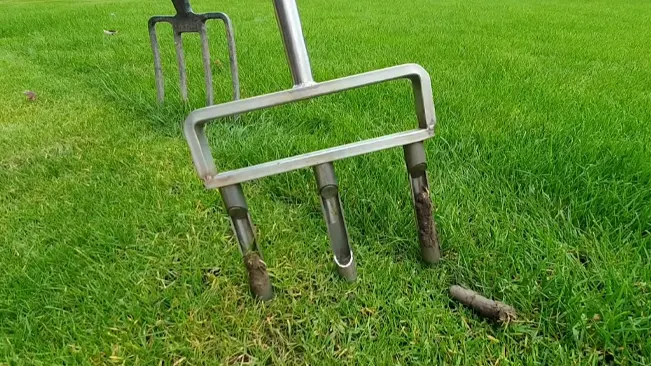
Hand-held aerators are essential tools for those looking to target specific problem areas within their lawns without aerating the entire area. These manual devices are equipped with solid tines or spikes that penetrate the soil, creating small holes that enhance the lawn’s ability to breathe and absorb essential nutrients. Hand-held aerators are ideal for gardeners with small to medium-sized lawns who prefer a more hands-on approach to lawn care. They offer the precision needed to address compacted spots or areas around tree roots where larger equipment might cause damage. Despite requiring more physical effort than mechanized options, hand-held aerators are valued for their control and effectiveness in improving lawn health.
Push Spike Aerators
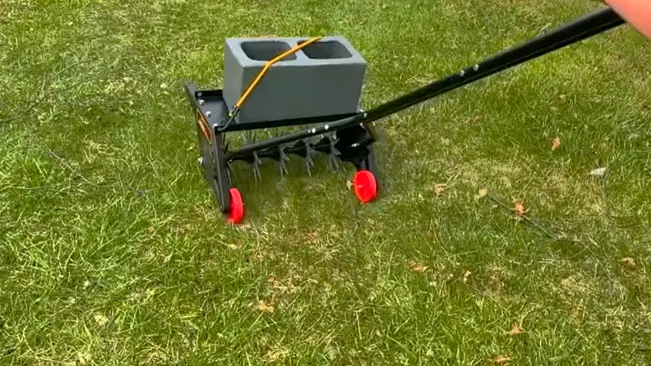
Push spike aerators are an excellent middle ground between manual hand-held aerators and more extensive tow-behind models. These devices are designed like traditional lawnmowers but are fitted with a series of solid spikes instead of cutting blades. As the aerator is pushed across the lawn, these spikes penetrate the soil, creating aeration holes that help improve water, nutrient, and air flow to the grass roots. Push spike aerators are particularly suited for medium-sized lawns, offering a balance between efficiency and manual control. They provide a more rapid and less labor-intensive aeration process than hand-held aerators, making them a popular choice for homeowners looking to maintain their lawns with relative ease.
Tow-Behind Spike Aerators
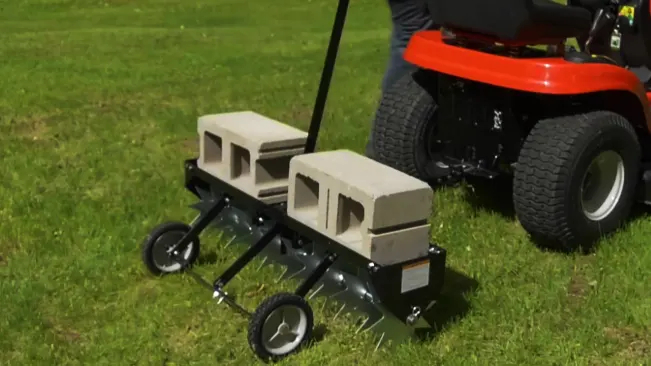
Tow-behind spike aerators are the heavy-duty champions of lawn aeration, designed for use with garden tractors or ride-on mowers. These aerators feature a robust frame equipped with solid spikes that deeply penetrate the soil, creating extensive aeration channels as they are towed across the lawn. Ideal for large lawns or commercial properties, tow-behind aerators significantly reduce the time and effort required for aeration, making it possible to cover vast areas efficiently. Their compatibility with tractors and ride-on mowers leverages the power of these vehicles, turning aeration into a more manageable and less time-consuming task.
Spike Aerator Rollers
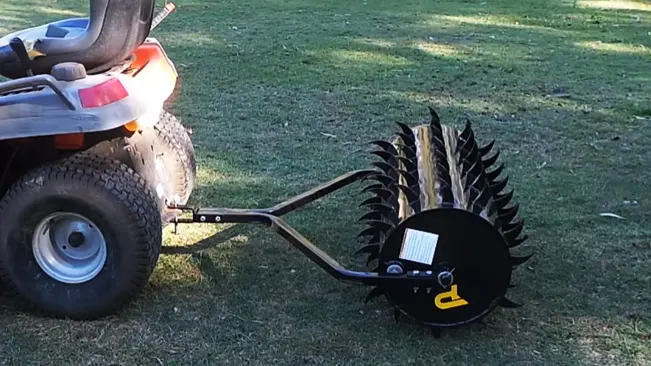
Spike aerator rollers offer a versatile and straightforward solution to lawn aeration, suitable for a wide range of lawn sizes. These cylindrical tools are covered in solid spikes and can be manually rolled over the lawn to create aeration holes. The simplicity of the design and the manual operation make spike aerator rollers an accessible tool for gardeners of all skill levels. Whether used on small urban lawns or larger suburban gardens, these rollers provide a practical way to improve soil aeration without the need for powered equipment. Their ease of use, combined with the ability to control the pressure and coverage, makes spike aerator rollers a favored choice for those seeking an effective and adaptable lawn aeration method.
Hollow Aeration Tools
Hand-Held Hollow Tine Aerators
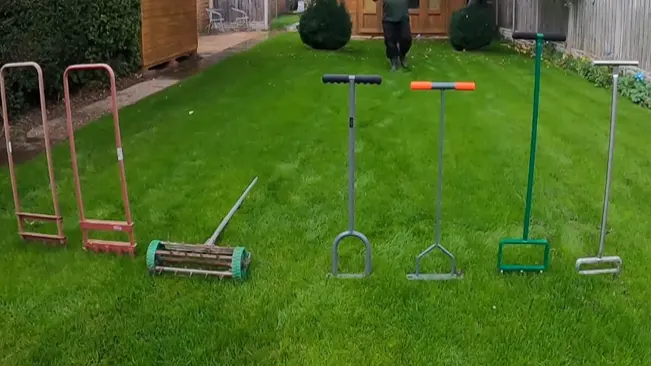
These are manual tools that feature hollow tines attached to a foot bar and a handle. To use them, you step on the foot bar to drive the tines into the soil, and then pull the tool out, extracting plugs of soil in the process. Hand-held hollow tine aerators are great for small lawns or treating specific compacted areas. They require a fair amount of physical effort but are an excellent option for gardeners who prefer a hands-on approach and have smaller areas to manage.
Hollow Tine Aeration Forks
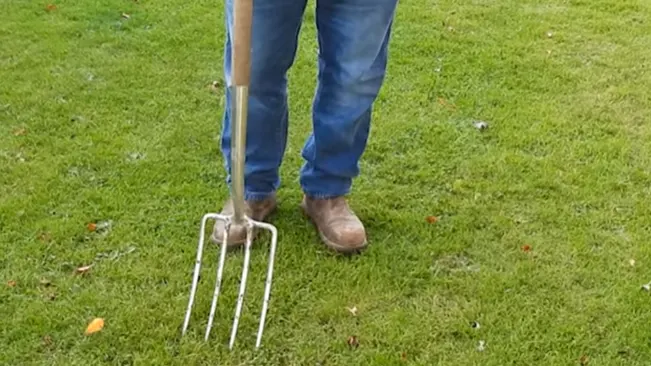
Similar to hand-held aerators but with a design akin to a traditional garden fork, these tools have hollow tines instead of solid ones. They are ideal for aerating small to medium-sized lawns or areas that are difficult to reach with larger machinery. Using a hollow tine aeration fork involves physically piercing the soil to remove soil cores, which can be labor-intensive but very effective for targeted aeration.
Push-Style Hollow Tine Aerators
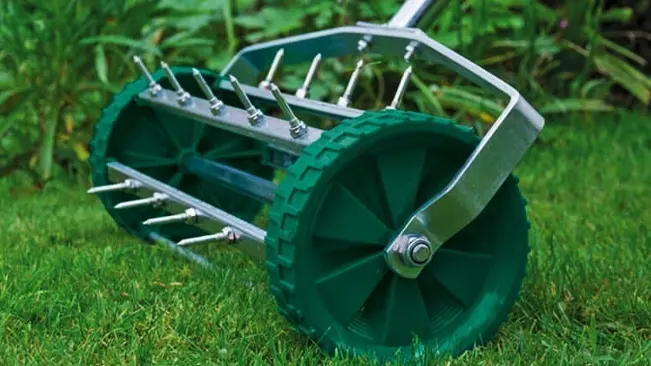
These tools resemble push mowers and are equipped with a series of hollow tines at the base. As you push the aerator across the lawn, the hollow tines remove plugs of soil, leaving behind open channels in the soil. Push-style hollow tine aerators are more efficient than hand-held models and are suitable for medium-sized lawns, making them a practical choice for homeowners looking to balance efficiency with physical effort.
Aeration Techniques and Tips
Aeration Techniques
- Choosing the Right Time: The best time to aerate your lawn depends on the grass type. For cool-season grasses, early fall or spring are ideal, as these grasses grow most vigorously during cooler months. Warm-season grasses benefit most from aeration in late spring to early summer, just before their peak growing season.
- Soil Moisture Level: Aerate your lawn when the soil is moist but not saturated. Watering your lawn a day before aeration can make the process easier, especially for manual aeration tools. Avoid aerating when the soil is too dry or too wet, as this can cause damage to the lawn and make the process less effective.
- Using the Right Equipment: Choose between solid and hollow tine aerators based on your lawn’s needs. Solid tine aerators are suitable for sandy soils or minor compaction, while hollow tine aerators are better for relieving severe compaction and clay-heavy soils.
- Pattern and Coverage: Ensure thorough coverage by aerating in a pattern that covers each area of the lawn. Overlap passes slightly with mechanical aerators to ensure no spot is missed. For extremely compacted soils, consider aerating in multiple directions.
- Dealing with Soil Plugs: After using a hollow tine aerator, leave the soil plugs on the lawn to decompose naturally. They will break down and return nutrients to the soil. If desired, they can be broken up more quickly by lightly dragging a piece of chain link fence or a lawn roller over them.
Aeration Tips
- Combining with Overseeding: Aeration creates an ideal environment for grass seed to germinate. Overseeding immediately after aeration can help to fill in bare patches and improve the density of your lawn.
- Top-Dressing: After aeration, consider top-dressing your lawn with a thin layer of compost or topsoil. This can enhance soil quality, introduce beneficial microorganisms, and help level out uneven areas.
- Regular Maintenance: Regular aeration, typically once a year for most lawns, can prevent compaction from becoming a severe problem. High-traffic areas may benefit from more frequent aeration.
- Adjusting Frequency Based on Soil Type: Lawns with heavy clay soil or those subject to high traffic may require more frequent aeration, possibly twice a year, to maintain optimal soil structure.
- Proper Lawn Care Post-Aeration: After aeration, continue with good lawn care practices such as proper watering, mowing at the correct height, and applying fertilizer as needed to support healthy growth.
When to Aerate Your Lawn?
For Cool-Season Grasses
Cool-season grasses, such as Kentucky bluegrass, fescue, and ryegrass, thrive in the cooler temperatures of fall and spring. The ideal time to aerate lawns with these types of grasses is early fall. Aeration at this time promotes root growth and helps the lawn recover before entering winter dormancy. Spring is also a suitable time, but it’s essential to wait until the grass has fully greened up and the soil has recovered from winter wetness. Avoid spring aeration if you plan to apply pre-emergent herbicides, as aeration can disrupt the herbicide barrier, reducing its effectiveness against weeds.
For Warm-Season Grasses
Warm-season grasses, like Bermuda, Zoysia, St. Augustine, and centipede grass, grow most actively during the warmer months of late spring and summer. For these lawns, the best aeration period is late spring to early summer. Aeration at this time bolsters the grass during its peak growth phase, leading to a more vigorous lawn throughout the summer.
Common Mistakes to Avoid in Lawn Aeration
- Aerating at the Wrong Time: Timing is crucial for successful aeration. Aerating cool-season grasses during the peak of summer heat can stress the lawn, while aerating warm-season grasses in late fall can leave them vulnerable to winter damage. Aim to aerate cool-season grasses in early spring or fall and warm-season grasses in late spring to early summer.
- Aerating Too Frequently or Infrequently: Over-aerating can damage a healthy lawn, leading to unnecessary stress on the grass. Conversely, not aerating enough can allow compaction and thatch to build up, stifling your lawn’s growth. Most lawns benefit from annual aeration, but high-traffic areas or lawns with heavy clay soil may need it more frequently.
- Ignoring Soil Moisture: Aerating when the soil is too dry can make the process ineffective and potentially damage the lawn. Aerating when the soil is too wet can lead to further compaction and damage the structure of the soil. The soil should be moist but not saturated for effective aeration.
- Using the Wrong Aeration Method: Solid tine aeration can be less effective on heavy, compacted clay soils and may even increase compaction around the holes. On the other hand, hollow tine aeration might be unnecessary for sandy soils or lightly compacted areas. Choose the method that best suits your lawn’s condition and soil type.
- Failing to Overlap Passes: Particularly with mechanical aerators, failing to overlap passes can result in uneven aeration, leaving untreated patches that can contribute to uneven growth and compaction.
- Not Maintaining Aeration Equipment: Dull or damaged tines can make the aeration process less effective and more challenging. Regularly inspect and maintain your aeration tools to ensure they’re in good working order.
- Ignoring Post-Aeration Care: After aeration, it’s essential to continue proper lawn care practices. Neglecting watering, fertilizing, or overseeding (if planned) after aeration can reduce the benefits of the aeration process.
- Leaving Soil Plugs on the Lawn Surface: While it’s generally recommended to leave the soil plugs on the lawn to decompose naturally, in some cases, they can smother grass if left in thick layers or if the lawn is heavily compacted with clay soil. In such cases, breaking up the plugs or removing them may be necessary.
- Aerating a Newly Seeded Lawn: Aerating too soon after seeding can disturb the young grass plants and hinder their development. It’s best to wait until the new grass is well-established before aerating.
- Overlooking Thatch Buildup: While aeration can help manage thatch to some extent, significant thatch buildup may require dethatching before aeration. Aerating without addressing severe thatch problems may not resolve underlying issues.
Conclusion
In conclusion, lawn aeration plays a crucial role in maintaining a healthy and vibrant lawn by enhancing root growth and soil resilience. Choosing the appropriate aeration method and timing is key to its success. Avoiding common pitfalls, such as improper timing and neglecting post-aeration care, is essential. With regular and proper aeration, complemented by good lawn care practices, even a dull lawn can be revitalized into a lush, thriving green space.
FAQs
- How often should I aerate my lawn?
It depends on your lawn’s condition and soil type. Generally, once a year is sufficient for most lawns, but those with heavy clay soil or high foot traffic may benefit from biannual aeration. - Can I aerate my lawn too much?
Yes, over-aeration can damage the grass roots and soil structure. Stick to the recommended frequency for your lawn’s needs. - Should I remove the soil plugs left after hollow aeration?
No, it’s best to leave them on the lawn. They will break down naturally and return valuable nutrients to the soil. - What’s the best time of day to aerate my lawn?
There’s no specific best time of day, but it’s advisable to aerate when the soil is moist, such as the day after a light rain or watering. - Can I walk on my lawn immediately after aeration?
Yes, but minimize traffic to allow your lawn to recover and absorb the full benefits of aeration.

Joel Cunningham
Forestry AuthorI'm Joel Cunningham, an expert in pruning and weed management with over a decade of experience. My skills are rooted in formal training and extensive practice, focusing on advanced pruning techniques and efficient weed control. I'm known for my quality work, precision, and deep understanding of plant health and soil dynamics. My contributions extend to educational initiatives where I share sustainable practices and advice, establishing myself as a reliable and authoritative figure in the gardening community.




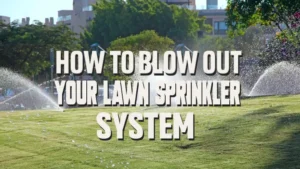
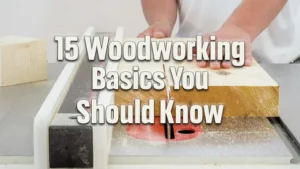
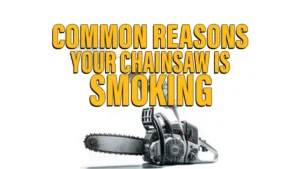



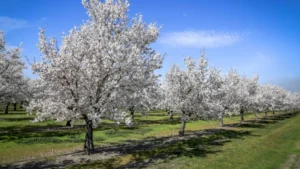
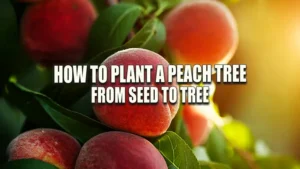

Leave your comment